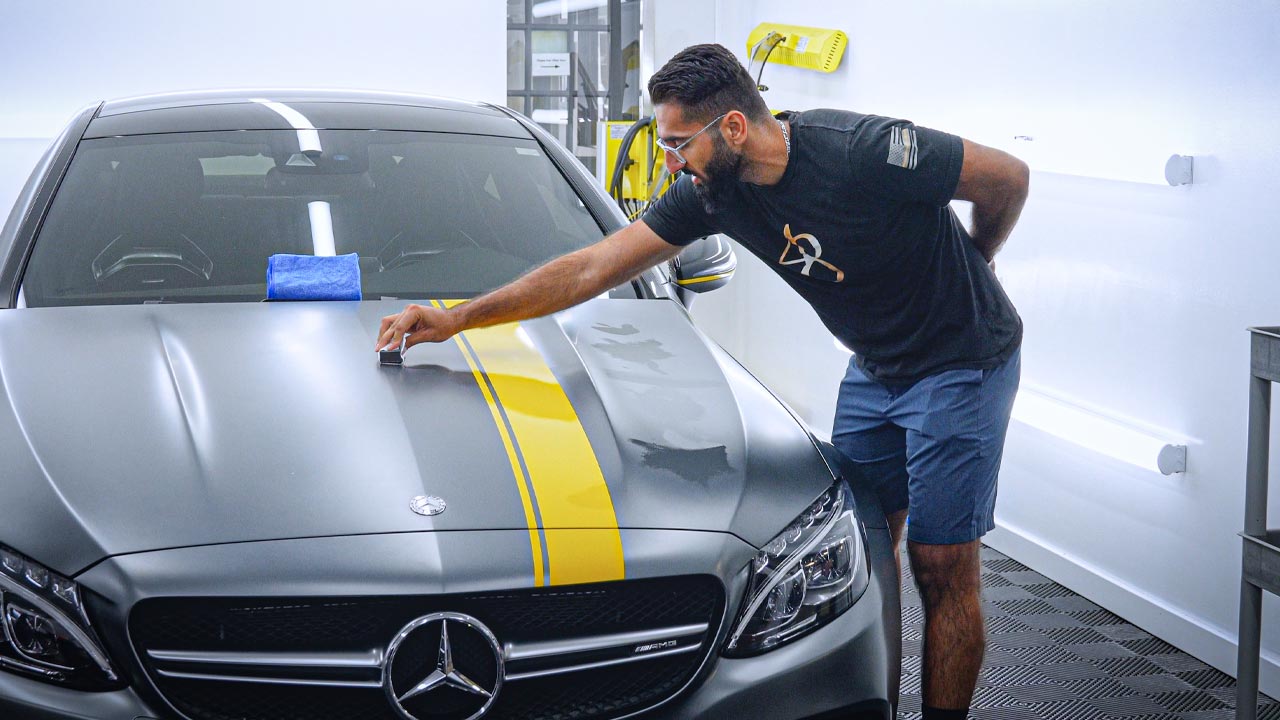Just How Explaining Porcelain Layer Improves the Longevity of Your Vehicle's Paint
Ceramic covering has actually emerged as a critical technology in automotive describing, offering a long-lasting option for preserving the stability of your cars and truck's paint. Recognizing the complexities of how ceramic layer works and its benefits over standard wax can offer valuable insights for automobile owners.
What Is Ceramic Coating?
Comprehending the protective advantages of ceramic finishing starts with acknowledging its structure and functionality. Ceramic finishing is a fluid polymer used to the outside surface areas of automobiles, mostly created to improve and safeguard automotive paint. The key component of this coating is silicon dioxide (SiO2), which is originated from all-natural products like sand. This compound forms a solid chemical bond with the manufacturing facility paint, producing a protective layer that is both durable and hydrophobic.
The covering's application entails careful prep work of the car's surface, which need to be without impurities, scrapes, and imperfections to make certain optimal attachment. As soon as used, the ceramic finish cures to form an inflexible shield that can withstand numerous environmental variables, including UV rays, chemical discolorations, and oxidation.
Furthermore, ceramic coatings are not simply surface-level therapies; they permeate the paint to give an enduring protection. This performance expands the lifespan of the automobile's aesthetic appeals while maintaining its value with time. Understanding these essential facets of ceramic finishing is crucial for automobile proprietors looking for effective options for paint conservation and improvement.
Benefits of Ceramic Finishing
The benefits of ceramic covering prolong much past its basic protective functions - Conforti Auto and Marine Detailing Ceramic Coating. Among the most considerable benefits is its capacity to provide remarkable longevity. Unlike traditional wax or sealants, ceramic finishings develop a solid bond with the vehicle's paint, allowing it to stand up to ecological threats such as UV rays, acid rainfall, and roadway salt. This resilience considerably minimizes the danger of paint damages, protecting the car's visual appeal.
Additionally, ceramic coatings supply hydrophobic properties, indicating they ward off water and contaminants. This particular not only makes the lorry much easier to clean however also decreases the frequency of cleaning, saving both time and initiative for automobile owners. The glossy surface area produced by the coating stops dirt and gunk from adhering, improving the car's total tidiness.
Additionally, ceramic coverings boost the depth and clearness of the paint, giving automobiles a shiny finish that is aesthetically striking. This visual enhancement better contributes to preserving the car's resale value, as a properly maintained exterior is a major marketing factor for prospective customers. Overall, the benefits of ceramic layer make it a worthwhile financial investment for any person wanting to secure and boost their vehicle's paintwork.
Exactly How Ceramic Coating Works

The finishing's hydrophobic properties push back water and dust, protecting against the buildup of gunk externally. This not just makes the automobile simpler to clean yet likewise decreases the possibility of scratches and swirl marks triggered by traditional washing methods. In addition, the ceramic layer functions as a shield against UV rays, which can create fading and oxidation over time.
When cured, the coating displays exceptional resistance to chemicals, consisting of roadway salts, bird droppings, and tree sap, which can otherwise harm the paint. The longevity of ceramic finishes can last for numerous years, depending on variables such as maintenance and ecological problems. Overall, the chemical bonding procedure of ceramic coverings gives a robust protection that maintains the stability and look of a vehicle's paintwork.
Comparing Ceramic Covering to Wax
Contrasting ceramic covering to typical wax reveals significant differences in performance and durability. While both items aim to shield a vehicle's paint, their structures and resilience established them apart. Wax, typically made from natural carnauba or artificial products, provides a short-term shield that usually lasts just a few weeks to a couple of months, depending on environmental problems and upkeep routines.
In contrast, ceramic layers are advanced options made up of not natural products that bond chemically with the vehicle's paint. This produces a durable, semi-permanent layer of defense that can endure for several years. As an outcome, ceramic finishings supply premium resistance to UV rays, chemical stains, and physical abrasion, dramatically lowering the danger of oxidation and fading.
In more info here addition, the hydrophobic homes of ceramic finishes make certain that water grains up and rolls off the surface, making it extra hard for dust and crud to adhere. This convenience of cleansing is a notable advantage over wax, which can bring in dirt and need frequent reapplication. Inevitably, for car owners looking for lasting protection and enhanced visual charm, ceramic coverings provide a more efficient alternative to typical wax items.
Upkeep Tips for Durability
Appropriate upkeep is important for making the most of the durability of a ceramic finish. Utilize a pH-balanced automobile shampoo to prevent deteriorating the layer, and avoid automatic cars and truck cleans with extreme brushes that can cause micro-scratches.
To keep the hydrophobic residential properties of the ceramic layer, consider applying an upkeep spray or booster particularly made for ceramic layers every couple of months. This will certainly strengthen the safety layer and improve water beading.
In addition, avoid exposing the covered surface to extreme environmental conditions whenever feasible. Auto parking in shaded areas or making use of a car cover can protect against UV damages and contamination from bird droppings, tree sap, or industrial results.
Finally, check the layer occasionally for indications of wear or damage. If you discover a reduction in hydrophobic actions, it might be time for a specialist reapplication. By adhering to these maintenance suggestions, automobile proprietors can significantly extend the life and efficiency of their ceramic finish, guaranteeing that their car's paint stays secured and aesthetically appealing for years ahead.
Conclusion
